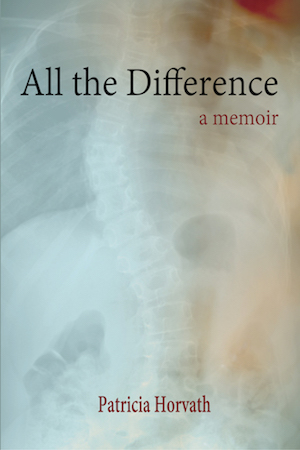Synopsis
 All the Difference is a captivating account of the author’s transformation from a visibly disabled young woman to someone who could, abruptly, “pass” for able-bodied. In prose that is searing and humorous Patricia Horvath details her experiences with bracing and spinal fusion, as she considers family dynamics, the literature of physical transformation, and how folk and fairy tales shape our attitudes towards the disabled.
All the Difference is a captivating account of the author’s transformation from a visibly disabled young woman to someone who could, abruptly, “pass” for able-bodied. In prose that is searing and humorous Patricia Horvath details her experiences with bracing and spinal fusion, as she considers family dynamics, the literature of physical transformation, and how folk and fairy tales shape our attitudes towards the disabled.
Read an Excerpt
Caged
I may as well admit it, I’m poorly put together. My body leans sharply to the left. I’m brittle- boned, stoop-shouldered, with an “S” shaped spine. I cannot touch my toes, ice skate, or ride a bike. My right shoulder blade and hipbone stick out too far, and my right leg is a half-inch shorter than my left. When I walk, my right foot swings wildly to the side. On its own trajectory, my foot will skim the sidewalk’s detritus: potato chip bags, stones, bottle caps. My ex-boyfriend called it my “trick foot.” We’d pass, say, a dented car or battered-looking hydrant. “Look what the trick foot did!” he’d exclaim and I’d laugh, wanting to be a good sport. It’s important to be seen as a good sport when one is, in fact, completely unathletic.
The hard plastic corset buckled in back with a thick leather strap. Attached to this new torso were metal suspenders. I stepped into the brace, put my arms through the suspenders, and grabbed the dresser for support. My mother tugged and tugged. The strap was heavy; it had no give. This was her first attempt at shackling me, and she was having trouble. The corset bumped against my hips. I sucked in my stomach. My mother pulled harder on the strap. I was a debutante being corseted for the antebellum ball. She gave one final emphatic tug and the brace shifted into place on my hips. I could feel the strap buckling, a screw being tightened at the back of my head. I looked at my reflection, looked away. This was me now— these metal bars, these bolts and screws. I pulled up my jeans, but they wouldn’t fit over my hips. My shirt was too tight to button. The brace’s weight was incredible, a second body to lug. I was tall and slim, but caged I was a heavy, clunky thing. The corset made me stick out in back. I needed pants large enough to fit over my plastic torso, shirts that could accommodate my metal shoulder blades. But my limbs had not grown longer. My new, double-digit sized clothes were too long in the leg and arm. My mother spent evenings hemming my jeans, but do hemmed Levis ever look right?
Shirts were especially difficult. The brace had numerous gadgets and straps. One white strap cut across my abdomen, another attached to the bars just above my clavicle and would peek out from low-necked shirts. Even in summer I wore turtlenecks and scarves.